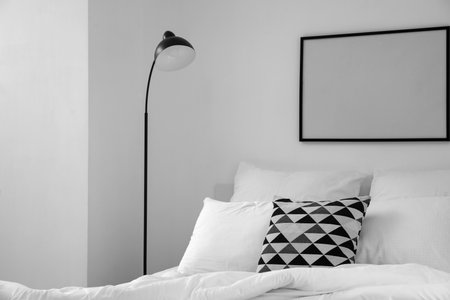Introduction to Minimalist Bedroom Design
In today’s fast-paced American lifestyle, many homeowners are turning to minimalist bedroom design as a way to reclaim peace and simplicity in their personal spaces. But what exactly does minimalist design mean when it comes to the bedroom? At its core, minimalism is about embracing the philosophy of “less is more”—focusing on essentials, reducing clutter, and creating an environment that feels calm and intentional. This trend has surged in popularity across the United States as more people realize that a pared-down bedroom isn’t just stylish; it can also foster a sense of tranquility and well-being. By stripping away excess and making thoughtful choices about what stays in the room, minimalist bedrooms offer a retreat from the noise and busyness of everyday life, allowing for better rest and relaxation. In this article, we’ll explore why this approach resonates with so many Americans and how it’s transforming modern home design.
2. The Psychological Benefits of a Minimalist Space
Minimalist bedroom design goes far beyond aesthetics—it has real psychological benefits that can greatly improve your well-being. When you declutter your bedroom, you’re not just creating more physical space; you’re also making room for mental clarity and emotional calm. Studies show that cluttered environments are linked to increased stress levels, anxiety, and even trouble sleeping. By removing excess items and focusing on what truly matters, you invite peace and relaxation into your nightly routine.
How Decluttering Reduces Stress
A minimalist space is proven to lower cortisol levels, the hormone associated with stress. With fewer distractions around, your mind can settle, allowing you to rest better and recharge each night. This sense of order helps eliminate the overwhelming feeling that comes from a messy or overcrowded room.
Comparing Cluttered vs. Minimalist Bedrooms
| Cluttered Bedroom | Minimalist Bedroom |
|---|---|
| Visual Overwhelm | Calm Visuals |
| Harder to Relax | Easier to Unwind |
| Disrupted Sleep | Improved Rest |
| Increased Anxiety | Reduced Stress |
Creating a Peaceful Environment
By embracing minimalist principles—such as neutral colors, simple furniture, and intentional decor—you set the stage for tranquility. Each item in your bedroom should have a purpose or bring you joy. When every object feels intentional, your space becomes a sanctuary where you can escape the pressures of daily life and truly relax.
![]()
3. Essential Elements of a Minimalist Bedroom
If you want to embrace minimalist bedroom design, understanding its essential elements is key. At the heart of minimalism is the idea that every piece serves a purpose and contributes to a calming, clutter-free environment. Start with a neutral color palette—think whites, soft grays, beiges, or muted earth tones. These shades help create an open, airy feeling and make your bedroom feel instantly more peaceful.
Simple furniture is another cornerstone of minimalist design. Choose pieces with clean lines and understated profiles. A platform bed, a sleek dresser, and streamlined nightstands are great choices. Avoid ornate details or bulky items; instead, opt for quality over quantity. Each item should enhance the functionality of your space without overwhelming it.
Storage solutions are also critical in keeping your minimalist bedroom organized. Built-in closets or under-bed storage can keep personal items out of sight, maintaining that uncluttered look. Finally, limit decorative objects to just a few meaningful pieces—a favorite artwork, a single vase, or a small plant—to add personality while preserving simplicity.
Tips for Decluttering and Organizing
Embracing a minimalist bedroom isn’t just about buying fewer things—it’s about creating a peaceful environment that works for your real life. For busy Americans juggling work, family, and social commitments, practical strategies are key to paring down belongings and keeping things organized. Here are some actionable tips to help you get started and maintain order long-term:
Start Small and Stay Consistent
Instead of overwhelming yourself with a full-room overhaul, tackle one area at a time—like your nightstand or dresser drawers. Set aside 10–15 minutes each day for decluttering. This method fits into even the busiest schedules and helps build lasting habits.
Use the “Four-Box” Declutter Method
| Box 1 | Box 2 | Box 3 | Box 4 |
|---|---|---|---|
| Keep | Donate | Trash | Relocate |
Sort every item you pick up into one of these boxes. This approach provides clarity and prevents decision fatigue as you work through your space.
Create Easy-to-Maintain Storage Solutions
- Opt for under-bed storage bins for seasonal clothes or spare linens.
- Add drawer organizers to separate essentials like socks, jewelry, or tech accessories.
- Install floating shelves to keep surfaces clear while displaying a few meaningful items.
Adopt a One-In, One-Out Rule
This rule is simple: whenever you bring something new into your bedroom (like a pillow or decor item), commit to removing an existing item. It’s an effective way to prevent clutter from creeping back in.
Schedule Regular Check-Ins
Add quarterly reminders to your calendar for a quick “stuff audit.” Life changes fast—what was necessary last year may no longer fit your needs or style. These check-ins help keep your bedroom streamlined and stress-free.
A minimalist bedroom isn’t about perfection; it’s about making intentional choices that support your peace of mind—even on your busiest days.
5. Choosing the Right Decor and Textiles
When it comes to minimalist bedroom design, every item you choose should serve a purpose or spark joy without adding clutter. Start with bedding—opt for high-quality, breathable fabrics like organic cotton or linen in neutral colors such as white, soft gray, or beige. These shades reflect light and create an airy, peaceful atmosphere. Avoid loud patterns; instead, go for subtle textures or single-toned duvet covers and throw blankets that add warmth without overwhelming the senses.
For wall art, less is definitely more. Select one or two pieces that evoke calmness, like serene landscapes, abstract prints, or simple black-and-white photography. A large piece above the headboard can act as a focal point while keeping the rest of the walls clean. If you want to display personal photos, use matching frames and keep the arrangement symmetrical to maintain visual harmony.
Decorative accents should be intentional and meaningful. Choose one or two statement pieces—perhaps a ceramic vase with fresh greenery or a sculptural lamp—that introduce organic shapes and natural materials into your space. Nightstands should be kept tidy with only essential items like a book, a small dish for jewelry, or a candle in a calming scent such as lavender or sandalwood.
Don’t underestimate the impact of area rugs and curtains. A plush rug in a muted tone can anchor the room and soften hardwood floors, while sheer drapes allow natural light to filter in gently, enhancing the tranquil vibe. Stick to one or two textiles per room to avoid visual chaos and ensure every element feels cohesive.
Ultimately, the goal is to curate rather than decorate. By carefully selecting decor and textiles that prioritize comfort and tranquility, you’ll create a minimalist bedroom that feels both calm and inviting—a true retreat from the hustle of everyday American life.
6. Sustaining the Minimalist Lifestyle
Creating a minimalist bedroom is just the beginning—the true challenge lies in maintaining that calming simplicity over time. To keep your space clutter-free and peaceful, start by developing mindful habits. Make it a routine to assess your belongings regularly, perhaps once every season, and let go of anything that no longer serves you or brings joy. This ongoing decluttering process keeps your room from returning to chaos.
Consistency is key in a minimalist lifestyle. Set boundaries for what enters your space by adopting a “one in, one out” rule: if you buy something new, donate or discard an old item. Prioritize quality over quantity when shopping for furniture or decor, choosing pieces that are both functional and timeless. This not only minimizes clutter but also aligns with sustainability values cherished in American culture.
Another helpful habit is to incorporate daily tidying into your routine. Spend just a few minutes each morning or evening making your bed, putting clothes away, and resetting surfaces. These small actions have a big impact on maintaining peace and order. Consider establishing a “no-drop zone” policy—don’t allow random items to accumulate on nightstands or dressers.
Finally, protect your sanctuary by keeping it technology-light. Limit screens and electronic distractions in your bedroom to preserve its role as a restful retreat. Use this space for relaxation, reading, or meditation instead of work or social media scrolling. Embracing these routines ensures that your minimalist bedroom remains a source of tranquility and well-being for the long haul.


